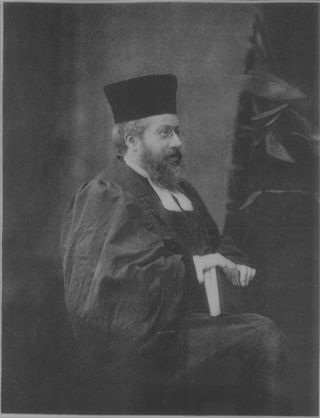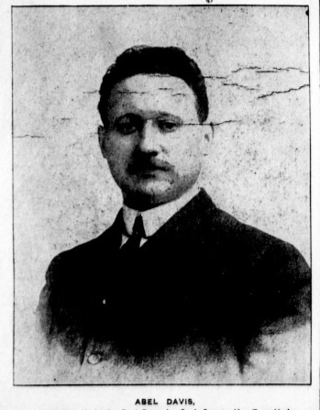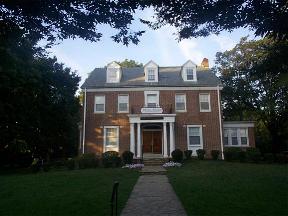
Dankmar Adler was a German-born American architect and civil engineer. He is best known for his fifteen-year partnership with Louis Sullivan, during which they designed influential skyscrapers that boldly addressed their steel skeleton through their exterior design: the Wainwright Building in St. Louis, Missouri (1891), the Chicago Stock Exchange Building (1894), and the Guaranty Building in Buffalo, New York (1896).

Hermann Adler HaKohen CVO was the Chief Rabbi of the British Empire from 1891 to 1911. The son of Nathan Marcus Adler, the 1911 Encyclopædia Britannica writes that he "raised the position [of Chief Rabbi] to one of much dignity and importance."

Kaufmann Kohler was a German-born Jewish American biblical scholar and critic, theologian, Reform rabbi, and contributing editor to numerous articles of The Jewish Encyclopedia (1906).

Pilgrim Baptist Church is a historic church located on the south side of Chicago, Illinois, USA. The landmarked building was originally constructed for a synagogue, Kehilath Anshe Ma'arav. The church is notable both as an architectural landmark and for the cultural contributions by the congregation of the church. Located at 3301 S. Indiana Ave, the church is in the heart of Chicago's Bronzeville neighborhood. In 2017, the church was sold to the National Museum of Gospel Music.
The history of Jews in Ohio dates back to 1817, when Joseph Jonas, a pioneer, came from England and made his home in Cincinnati. He drew after him a number of English Jews, who held Orthodox-style divine service for the first time in Ohio in 1819, and, as the community grew, organized themselves in 1824 into the first Jewish congregation of the Ohio Valley, the B'ne Israel. This English immigration was followed in the next two decades by the coming of German immigrants who, in contrast, were mostly Reform Jews. A Bavarian, Simson Thorman, settled in 1837 in Cleveland, then a considerable town, which thus became the second place in the state where Jews settled. Thorman was soon followed by countrymen of his, who in 1839 organized themselves into a congregation called the Israelitish Society. The same decade saw an influx of German Jews into Cincinnati, and these in 1841 founded the Bene Yeshurun congregation. To these two communities the Jewish history of Ohio was confined for the first half of the 19th century. In 1850 Ohio had six congregations: four in Cincinnati and two in Cleveland.

Congregation Mikveh Israel, is a Sephardic Orthodox Jewish synagogue located at 44 North Fourth Street in Philadelphia, Pennsylvania, in the United States. The congregation traces its history from 1740. Mikveh Israel is a Spanish and Portuguese congregation that follows the rite of the Amsterdam esnoga. It is the oldest synagogue in Philadelphia, and the longest running in the United States.
Menahem Shemuel Halevy was a prominent Iranian Rabbi of the early 20th century. He fought against persecution in Iran and wrote numerous books.
Henry Samuel Morais was an American writer and rabbi.

KAM Isaiah Israel is a Reform Jewish congregation and synagogue located at 1100 East Hyde Park Boulevard in the historic Kenwood neighborhood of Chicago, Illinois, in the United States. It is the oldest Jewish congregation in Chicago, with its oldest core founded in 1847 as Kehilath Anshe Ma'arav.
John Hays is the only Jew known to have come to Illinois prior to its admission in the Union. He was the son of Baruch Hays, a lieutenant in the American Revolution and scion of one of the oldest American Jewish families. John Hays settled in Illinois as early as 1793 and served for twenty years as sheriff of St. Clair County, in the southwestern part of Illinois, which was the most populous section of the state in its early days.

Temple Beth El is a Reform synagogue located at 7400 Telegraph Road, in Bloomfield Township, Oakland County, Michigan, in the United States. Beth El was founded in 1850 in the city of Detroit, and is the oldest Jewish congregation in Michigan. Temple Beth El was a founding member of the Union for Reform Judaism in 1873, and hosted the meeting in 1889 during which the Central Conference of American Rabbis was established.
Rabbi Arnold Jacob Wolf was an American Reform Rabbi, and a longtime champion of peace and progressive politics.

Brigadier General Abel Davis was an officer in the Illinois National Guard. He was regarded as "the second highest ranking Jewish officer in the Illinois National Guard, and one of the highest ranking Jewish officers in the United States Army." During World War I, he commanded the 132nd Infantry Regiment of the 33rd Division. Postwar, Davis commanded the 66th Infantry Brigade.

Few Jews arrived in Baltimore, Maryland, in its early years. As an immigrant port of entry and border town between North and South and as a manufacturing center in its own right, Baltimore has been well-positioned to reflect developments in American Jewish life. Yet, the Jewish community of Baltimore has maintained its own distinctive character as well.
The 2020 estimate of the Jewish population in metropolitan Chicago is around 319,600, according to Brandeis University's Chicago Report. The population of Jewish people within the City of Chicago's limits is estimated to be around 240,000, with another 80,000 residing in the suburbs surrounding the major city. At the end of the 20th century there were a total of 270,000 Jews in the Chicago area, with 30% in the city limits. In 1995, over 80% of the suburban Jewish population lived in the northern and northwestern suburbs of Chicago. At this time, West Rogers Park was the largest Jewish community within the city of Chicago. However, the Jewish population within the city had been declining and tended to be older and more well-educated than the Chicago average. The Jewish immigrants to Chicago came from many different countries, with the most common being Eastern Europe and Germany.
The history of the Jews in Illinois dates back to 1793, when John Hays, the region's first postmaster, settled in Cahokia from his native New York. The most prominent Jew in Illinois' early days was Abraham Jonas (politician), who moved to Quincy from Cincinnati in 1838. In 1842 he was elected to the Illinois Legislature, where he met Abraham Lincoln, and became his lifelong friend. Another early Jewish settler was Cap. Samuel Noah, the first Jewish graduate of West Point, who taught school at Mount Pulaski, Illinois in the late 1840s.

Emanuel Congregation is a Reform Jewish congregation and synagogue located at 5959 North Sheridan Road, in the Edgewater neighborhood of Chicago, Illinois, in the United States. The congregation was founded in 1880.
Bernhard Felsenthal was a German-born American rabbi.
Isaac S. Moses was a German-born Jewish-American rabbi.
Adolph S. Moses was a German-American rabbi who mainly ministered in Mobile, Alabama and Louisville, Kentucky.










